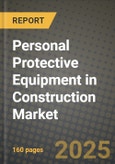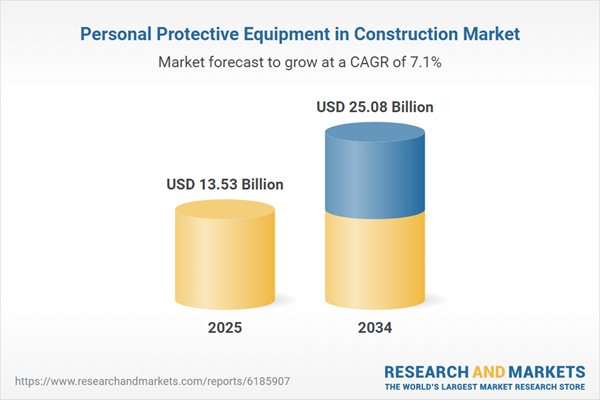Personal Protective Equipment In Construction Market
The personal protective equipment (PPE) in construction market spans head, eye/face, hearing, respiratory, hand, foot, fall protection, high-visibility apparel, protective clothing, and emerging “smart PPE” that embeds sensors and connectivity. End-uses range from residential and commercial building to industrial, infrastructure, tunneling, demolition, and refurbishment, each with distinct hazard profiles (height, dust/silica, noise, chemicals, heat/cold, electrical, struck-by). Trends include connected safety platforms (wearables + beacons + geofencing) that elevate situational awareness; lighter, more ergonomic designs using advanced polymers, foams, and textiles; modular kits for multi-trade crews; and sustainability via recyclable shells, bio-based materials, and refurbishment programs. Demand is propelled by elevated safety culture, stricter enforcement of OSHA/EN/ISO standards, rising complexity of megaprojects, and owner/insurer requirements that tie PPE compliance to access and premiums. Competition includes diversified industrials, specialist PPE makers, and digital safety startups; differentiation hinges on fit/comfort (driving compliance), compatibility with tools and harness systems, certified performance across climate extremes, and software ecosystems that turn field data into actionable insights. Procurement is professionalizing - framework agreements, rental/managed services, and vendor-managed inventory - while supply strategies emphasize dual sourcing, regional assembly, and rapid customization (branding, language, size runs). As contractors digitize permits-to-work and near-miss reporting, PPE is shifting from consumable to platform: hardware validated by third-party certifications, managed by service SLAs, and instrumented to feed leading indicators (exposure, proximity, fatigue). Vendors capable of pairing credible core PPE with connected safety, training, and lifecycle services are best positioned to capture value as projects demand measurable, auditable risk reduction.Personal Protective Equipment In Construction Market Key Insights
- From compliance to performance outcomes
- Smart PPE moves from pilots to fleet
- Silica and respirable dust reshape respiratory programs
- Fall protection sophistication increases
- Hand injuries push cut, impact, and dexterity innovation
- Head, eye, and hearing converge around comfort
- Heat, cold, and weather resilience
- Sustainability and circularity differentiate
- Service models and rental reduce downtime
- Change management and human factors
Personal Protective Equipment In Construction Market Reginal Analysis
North America
Strong enforcement and litigious environments drive premium, certified gear and documented fit-testing. Smart PPE adoption accelerates on infrastructure and energy jobs, integrating with incident management platforms. Contractors value rental and managed services for fall protection and respiratory fleets. Heat stress and wildfire smoke plans are standard; inclusion sizing and prescription eye protection are frequent requirements.Europe
CE-marked products, eco-design, and circularity push suppliers toward recyclable, repairable components and transparent materials disclosures. Rail, renewables, and urban builds demand climb-style helmets, advanced fall arrest, and hearing programs aligned to strict noise directives. Union engagement and formal safety committees influence selection; multilingual documentation and ergonomic proofs matter.Asia-Pacific
Mega-projects and rapid urbanization create scale demand, with growing emphasis on training and connected safety in mature markets. Heat and monsoon management shape apparel and footwear choices; respiratory programs expand for silica and welding fumes. Price dispersion is wide, but tier-one builders increasingly specify global brands with local service hubs and fast certification support.Middle East & Africa
High-temperature sites prioritize heat-stress mitigation, cooling textiles, and breathable helmets/hi-vis. Large infrastructure and energy builds use connected proximity and gas detection for complex, multi-contractor zones. Procurement favors turnkey service bundles (fit-testing, inspection, rental) and Arabic/English documentation; robust after-sales support is decisive given remote project locations.South & Central America
Mining, transport corridors, and industrial builds sustain demand for high-durability gloves, respiratory, and fall protection. Currency swings and import logistics favor regional assembly and vendor-managed inventory. Training, inspection tagging, and bilingual materials underpin compliance. Weather variability drives versatile apparel and footwear with strong anti-slip and water-resistant features.Personal Protective Equipment In Construction Market Segmentation
By Type
- Head Protection
- Face Protection
- Eye Protection
- Hearing Protection
- Protective Clothing
- Respiratory Protection
- Protective Footwear
- Fall Protection
- Hand Protection
- Disposable gloves
- Durable gloves
- Others
By Application
- Residential Construction
- Highway
- Bridge
- Others
Key Market players
3M, Honeywell, MSA Safety, Ansell, DuPont, Kimberly-Clark Professional, Lakeland Industries, Delta Plus Group, uvex safety (uvex group), JSP, Portwest, Bullard, Dräger, Guardian Fall Protection, HiltiPersonal Protective Equipment In Construction Market Analytics
The report employs rigorous tools, including Porter’s Five Forces, value chain mapping, and scenario-based modelling, to assess supply-demand dynamics. Cross-sector influences from parent, derived, and substitute markets are evaluated to identify risks and opportunities. Trade and pricing analytics provide an up-to-date view of international flows, including leading exporters, importers, and regional price trends.Macroeconomic indicators, policy frameworks such as carbon pricing and energy security strategies, and evolving consumer behaviour are considered in forecasting scenarios. Recent deal flows, partnerships, and technology innovations are incorporated to assess their impact on future market performance.
Personal Protective Equipment In Construction Market Competitive Intelligence
The competitive landscape is mapped through proprietary frameworks, profiling leading companies with details on business models, product portfolios, financial performance, and strategic initiatives. Key developments such as mergers & acquisitions, technology collaborations, investment inflows, and regional expansions are analyzed for their competitive impact. The report also identifies emerging players and innovative startups contributing to market disruption.Regional insights highlight the most promising investment destinations, regulatory landscapes, and evolving partnerships across energy and industrial corridors.
Countries Covered
- North America - Personal Protective Equipment In Construction market data and outlook to 2034
- United States
- Canada
- Mexico
- Europe - Personal Protective Equipment In Construction market data and outlook to 2034
- Germany
- United Kingdom
- France
- Italy
- Spain
- BeNeLux
- Russia
- Sweden
- Asia-Pacific - Personal Protective Equipment In Construction market data and outlook to 2034
- China
- Japan
- India
- South Korea
- Australia
- Indonesia
- Malaysia
- Vietnam
- Middle East and Africa - Personal Protective Equipment In Construction market data and outlook to 2034
- Saudi Arabia
- South Africa
- Iran
- UAE
- Egypt
- South and Central America - Personal Protective Equipment In Construction market data and outlook to 2034
- Brazil
- Argentina
- Chile
- Peru
Research Methodology
This study combines primary inputs from industry experts across the Personal Protective Equipment In Construction value chain with secondary data from associations, government publications, trade databases, and company disclosures. Proprietary modeling techniques, including data triangulation, statistical correlation, and scenario planning, are applied to deliver reliable market sizing and forecasting.Key Questions Addressed
- What is the current and forecast market size of the Personal Protective Equipment In Construction industry at global, regional, and country levels?
- Which types, applications, and technologies present the highest growth potential?
- How are supply chains adapting to geopolitical and economic shocks?
- What role do policy frameworks, trade flows, and sustainability targets play in shaping demand?
- Who are the leading players, and how are their strategies evolving in the face of global uncertainty?
- Which regional “hotspots” and customer segments will outpace the market, and what go-to-market and partnership models best support entry and expansion?
- Where are the most investable opportunities - across technology roadmaps, sustainability-linked innovation, and M&A - and what is the best segment to invest over the next 3-5 years?
Your Key Takeaways from the Personal Protective Equipment In Construction Market Report
- Global Personal Protective Equipment In Construction market size and growth projections (CAGR), 2024-2034
- Impact of Russia-Ukraine, Israel-Palestine, and Hamas conflicts on Personal Protective Equipment In Construction trade, costs, and supply chains
- Personal Protective Equipment In Construction market size, share, and outlook across 5 regions and 27 countries, 2023-2034
- Personal Protective Equipment In Construction market size, CAGR, and market share of key products, applications, and end-user verticals, 2023-2034
- Short- and long-term Personal Protective Equipment In Construction market trends, drivers, restraints, and opportunities
- Porter’s Five Forces analysis, technological developments, and Personal Protective Equipment In Construction supply chain analysis
- Personal Protective Equipment In Construction trade analysis, Personal Protective Equipment In Construction market price analysis, and Personal Protective Equipment In Construction supply/demand dynamics
- Profiles of 5 leading companies - overview, key strategies, financials, and products
- Latest Personal Protective Equipment In Construction market news and developments
Additional Support
With the purchase of this report, you will receive:- An updated PDF report and an MS Excel data workbook containing all market tables and figures for easy analysis.
- 7-day post-sale analyst support for clarifications and in-scope supplementary data, ensuring the deliverable aligns precisely with your requirements.
- Complimentary report update to incorporate the latest available data and the impact of recent market developments.
This product will be delivered within 1-3 business days.
Table of Contents
Companies Mentioned
- 3M
- Honeywell
- MSA Safety
- Ansell
- DuPont
- Kimberly-Clark Professional
- Lakeland Industries
- Delta Plus Group
- uvex safety (uvex group)
- JSP
- Portwest
- Bullard
- Dräger
- Guardian Fall Protection
- Hilti
Table Information
| Report Attribute | Details |
|---|---|
| No. of Pages | 160 |
| Published | November 2025 |
| Forecast Period | 2025 - 2034 |
| Estimated Market Value ( USD | $ 13.53 Billion |
| Forecasted Market Value ( USD | $ 25.08 Billion |
| Compound Annual Growth Rate | 7.1% |
| Regions Covered | Global |
| No. of Companies Mentioned | 15 |









